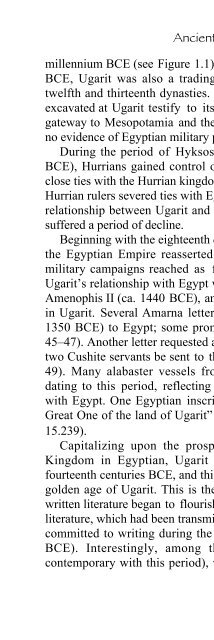A Primer on Ugaritic: Language, Culture, and Literature - enenuru
A Primer on Ugaritic: Language, Culture, and Literature - enenuru
A Primer on Ugaritic: Language, Culture, and Literature - enenuru
You also want an ePaper? Increase the reach of your titles
YUMPU automatically turns print PDFs into web optimized ePapers that Google loves.
Ancient Ugarit 13<br />
millennium BCE (see Figure 1.1). In the early sec<strong>on</strong>d millennium<br />
BCE, Ugarit was also a trading center for the Pharaohs of the<br />
twelfth <strong>and</strong> thirteenth dynasties. Several Middle Kingdom statues<br />
excavated at Ugarit testify to its role as an Egyptian commercial<br />
gateway to Mesopotamia <strong>and</strong> the Babyl<strong>on</strong>ian Empire, but there is<br />
no evidence of Egyptian military presence.<br />
During the period of Hyksos’ rule in Egypt (ca. 1674–1567<br />
BCE), Hurrians gained c<strong>on</strong>trol of Ugarit <strong>and</strong> the city maintained<br />
close ties with the Hurrian kingdom of Mitanni in north Syria. The<br />
Hurrian rulers severed ties with Egypt while seeking to enhance the<br />
relati<strong>on</strong>ship between Ugarit <strong>and</strong> Mesopotamia. The city of Ugarit<br />
suffered a period of decline.<br />
Beginning with the eighteenth dynasty during the Late Kingdom,<br />
the Egyptian Empire reasserted itself in north Syria. Egyptian<br />
military campaigns reached as far north as the Euphrates <strong>and</strong><br />
Ugarit’s relati<strong>on</strong>ship with Egypt was reestablished. By the time of<br />
Amenophis II (ca. 1440 BCE), an Egyptian garris<strong>on</strong> was stati<strong>on</strong>ed<br />
in Ugarit. Several Amarna letters were written from Ugarit (ca.<br />
1350 BCE) to Egypt; some promised allegiance to Pharaoh (EA<br />
45–47). Another letter requested an Egyptian physician al<strong>on</strong>g with<br />
two Cushite servants be sent to the Ugaritian King Niqmaddu (EA<br />
49). Many alabaster vessels from Egypt were found in Ugarit<br />
dating to this period, reflecting the rich commercial relati<strong>on</strong>ship<br />
with Egypt. One Egyptian inscripti<strong>on</strong> refers to “Niqumaddu, the<br />
Great One of the l<strong>and</strong> of Ugarit” (wr nh˙«st ik«riyty nyk«sûm{dy; RS<br />
15.239).<br />
Capitalizing up<strong>on</strong> the prosperity <strong>and</strong> stability of the Late<br />
Kingdom in Egyptian, Ugarit flourished in the fifteenth <strong>and</strong><br />
fourteenth centuries BCE, <strong>and</strong> this period is widely regarded as the<br />
golden age of Ugarit. This is the period from which the <strong>Ugaritic</strong><br />
written literature began to flourish. It is believed that <strong>Ugaritic</strong> epic<br />
literature, which had been transmitted orally for centuries, was first<br />
committed to writing during the reign of Niqmaddu II (ca. 1350<br />
BCE). Interestingly, am<strong>on</strong>g the Amarna letters (which are<br />
c<strong>on</strong>temporary with this period), we find a letter from the ruler of


